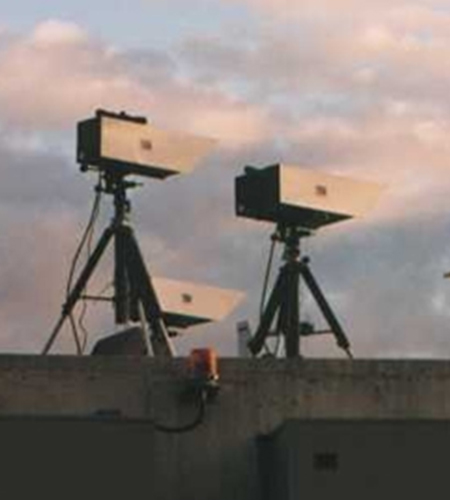Crosswinds & Atmosphere Turbulence
The Long-baseline Optical Anemometer (LOA™) measures path averaged crosswind and turbulence over distances of 100 meters to over 10 km. Based on optical scintillation technology, its optics ‘see’ the always present temperature and density variation in small parcels of air as they move through the
infrared beam.
OSI’s patented LOA sensors are based on advanced technology tested and approved by the National Oceanic and Atmospheric Administration (NOAA), the Environmental Technology Laboratories (ETL) and the Environmental Protection Agency (EPA).
LOA’s unique complete-path measurement and long-range power make it an ideal system for monitoring air movement in large-scale outdoor applications such as fenceline monitoring.
LOA-005 Fenceline Monitoring. Picture shows an example of how LOA-005 may be used in fenceline monitoring of a refinery area. In this case the refineries are located immediately adjacent to populated areas on the northwest, north, and east; and a wildlife protection area to the west. For the basis of example, seven LOA systems would be installed to monitor air movement along every inch of the line separating the refinery areas from the homes, businesses and ecologically vulnerable areas nearby. Note that the longest leg of the boundary (3 mi.) is about half of the LOA’s effective range
In the event of a release of hazardous, toxic, or lethal gas or material whether by accident, or by malicious intent, accurate measurement and modeling of air movement patterns can be invaluable to plant personnel, first responders, local officials – and all the people in the surrounding area – enabling them to quickly determine the extent of the hazard and to take the most effective action to prevent harm or loss of life.
LOA presents an unequalled answer to precision tracking of hazardous emissions large or small, enabling plant operators to exactly monitor and record air movement moment-by-moment over the entire refinery area.
LOA design, based on decades of field experience in harsh environments, results in a rugged and extremely reliable sensor, immune from the typical error sources. AGC circuitry eliminates the effects of LED output power drop, contaminated optics, or dusty air. Internal diagnostics monitor the system 24/7/365. Preventative maintenance (suggested every 6 months) is as simple as cleaning the windows and checking the aim. With DSP based design, no field calibration is needed. Ever.

